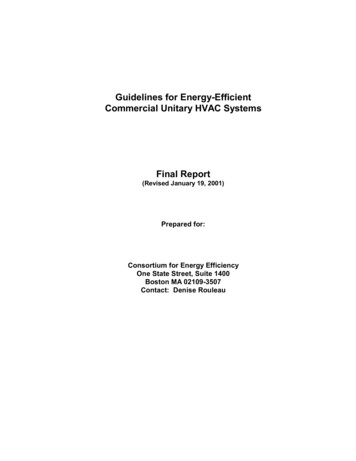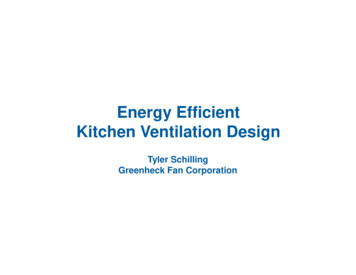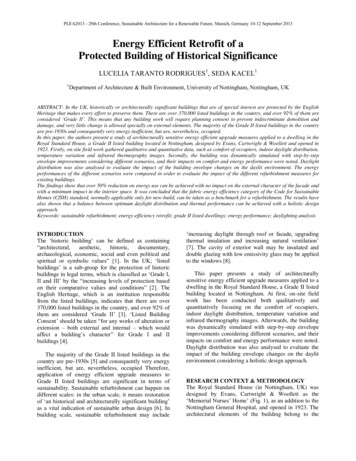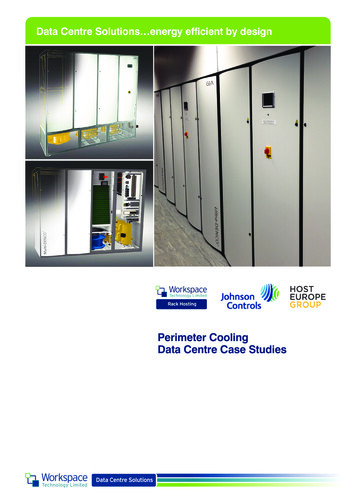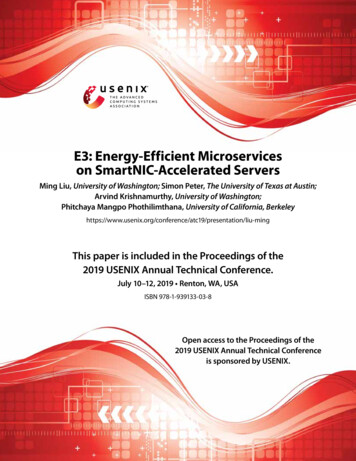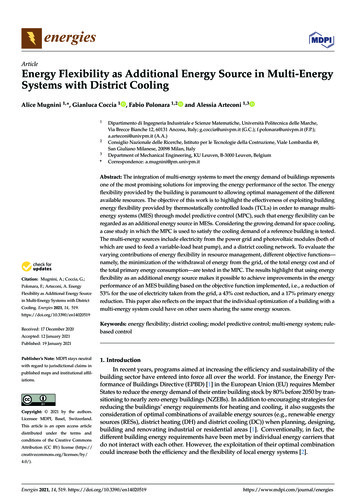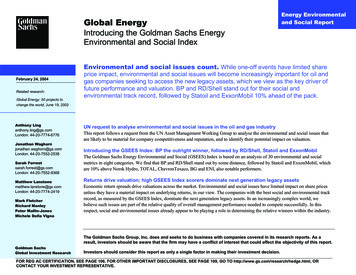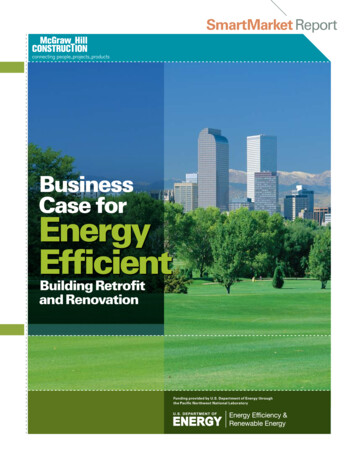
Transcription
SmartMarket ReportBusinessCase forEnergyEfficientBuilding Retrofitand RenovationProduced withsupport fromFunding provided by U.S. Department of Energy throughthe Pacific Northwest National Laboratory
Design and Construction IntelligenceSmartMarket ReportMcGraw-Hill ConstructionKeith FoxBusiness Case forEnergy Efficient BuildingRetrofit and RenovationSmartMarket ReportVice President, Product DevelopmentExecutive EditorKathryn E. CassinoHarvey M. Bernstein, F.ASCE, LEED APMcGraw-Hill ConstructionResearch & Analytics/AlliancesEditorial DirectorVice President, IndustryInsights & AlliancesEditorsPresidentMichele A. Russo, LEED APHarvey M. Bernstein, F. ASCE, LEED APEnver Fitch, LEED Green AssociateDonna Laquidara-Carr, LEED APSenior Director, Research & AnalyticsSenior Group Art DirectorBurleigh MortonFrancesca MessinaDirector, Partnerships & AlliancesContributing Art DirectorJohn GudgelDonald PartykaDirector, Green Content &Research CommunicationsProduction ManagerMichele A. Russo, LEED APAlison LorenzContributing EditorDavid SokolResearch Project ManagerDana Gilmore, MRA, PRCFor further information on thisSmartMarket Report or for anyin the series, please contactMcGraw-Hill ConstructionResearch & Analytics34 Crosby Drive, Suite 201Bedford, MA 017301-800-591-4462MHC Analytics@mcgraw-hill.comAcknowledgements:The authors wish to thank the many individuals who provided insights ontheir efficiency programs and projects for the case studies.In particular, we would like to thank Roland Risser and Joseph Hagerman atthe U.S. Department of Energy’s Building Technologies Program for providing strategic direction for this project. We also appreciate the assistance ofAndrew Nicholls at Pacific Northwest National Laboratory for his projectoversight.Finally, thank you to Mike Italiano, Capital Markets Partnership for sharinghis invaluable assistance and expertise regarding sustainability in theworld of financing and to Ken Black, E Source for his assistance.About McGraw-HillConstructionMcGraw-Hill Construction (MHC),part of The McGraw-Hill Companies, connects people, projects andproducts across the design and construction industry, serving owners,architects, engineers, general contractors, subcontractors, buildingproduct manufacturers, suppliers,dealers, distributors, and adjacentmarkets.A reliable and trusted sourcefor more than a century, MHC hasremained North America’s leadingprovider of construction project andproduct information, plans and specifications, industry news, marketresearch, and industry trends andforecasts. In recent years, MHC hasemerged as an industry leader in thecritical areas of sustainability andinteroperability as well.In print, online, and throughevents, MHC offers a variety of tools,applications, and resources thatembed in the workflow of our customers, providing them with theinformation and intelligence theyneed to be more productive,successful, and competitive.Backed by the power of Dodge,Sweets, Architectural Record,Engineering News-Record (ENR),GreenSource and SNAP,McGraw-Hill Construction servesmore than one million customerswithin global constructioncommunity. To learn more, visitus at www.construction.com.
SmartMarket ReportBusiness Case for Energy Efficient Building Retrofit and RenovationIntroductionThe opportunity for improvingenergy performance in the UnitedStates has never been greater. TheBetter Buildings Initiative proposedby the Obama administration is the latestnational effort drawing attention to our building energy consumption and ways we canhelp reduce it—and win at the same time.The economic downturn shifted theattention of firms and public owners withlarge building portfolios toward their existing buildings. With government and utilityincentives, the time was ripe for focusingon retrofit and renovation investments thatcould save energy and money.However, despite the fact that retrofitactivity remained active during the downeconomy, only a tiny portion of the U.S. building stock has been affected. The opportunityhas never been greater. We merely need tohelp create and seize those opportunities.In order to do so, it is important to understand what drives American companies andbuilding owners to adopt efficiency improvements and sustainability policies.Understanding those drivers is the firststep. Then, it is about making the businesscase to those different influence agents.We were excited that the U.S. Departmentof Energy’s Building Technology Programand the Pacific Northwest National Laboratory supported this effort because the resultsshow that energy efficiency is occurring andwill continue to occur. The levels of that activity depend on our ability to convey the fullbreadth of benefits that come from sustainable investments, of which energy efficiencyis just the tip of the iceberg.The research in this report provides newHarvey M. Bernstein, F.ASCE,LEED AP has been a leader inthe engineering and construction industry for over 30 years.Currently, he has lead responsibilities for MHC’s marketresearch group, including MHC’sthought leadership initiativesin areas such as green building,BIM, interoperability, innovation and global constructionmarkets. Bernstein was one ofthe team members involved inlaunching MHC’s GreenSourcemagazine. Previously, Bernsteinserved as President and CEO ofinsights that build on previous research byMcGraw-Hill Construction and others on howto create high-performing buildings. Somecritical results include: The commitment of corporate America tosustainability continues to grow, despitethe adverse economy: 42% of the firmssurveyed view sustainability as a businessopportunity or as transformational, upfrom 37% just a little over a year ago. 92% of companies report being influencedby operational savings in their decisionto pursue energy efficiency projects, butmarket differentiation (73%) and employeesatisfaction and productivity (71%) arealso important.Harvey M. BernsteinF.ASCE, LEED APVice PresidentIndustry Insights andAlliancesMcGraw-Hill Construction Renewable energy is seen as a potentialbusiness opportunity for some firms.It is obvious that the business case mattersto firms, and energy efficiency and utilitysavings are the foundation of that case, butfirms today expect more. Tenants are usingtheir influence in a high-vacancy commercial office building market to demand greenfeatures (see page 65), and firms want marketdifferentiation and competitive advantage.Whether you are a manufacturer trying toget your energy-efficient products installed,a builder or engineer experienced in addingvalue to projects through better buildingpractices, or policy makers wanting to lowerthe environmental impacts of our buildings,understanding how to make the right business case to the right person is critical.We hope the data and market insights inthis report help you make that case and seizethose opportunities.the Civil Engineering ResearchFoundation. He has writtennumerous papers covering innovation and sustainability andcurrently serves as a member ofthe Princeton University Civiland Environmental EngineeringAdvisory Council. He is a visiting professor with the Universityof Reading’s School of Construction Management and Engineering in England, where healso serves on their InnovativeConstruction Research CentreAdvisory Board. Bernstein hasan M.B.A. from Loyola College,McGraw-Hill Constructionan M.S. in engineering fromPrinceton University and aB.S. in civil engineering fromthe New Jersey Institute ofTechnology.Michele A. Russo, LEED AP,has been working in environmental policy and communications for 15 years. She currentlyis responsible for helpingdirect the green content acrossMHC’s portfolio of products andservices, including the management of MHC’s SmartMarketReport series. Russo is also a1www.construction.com Michele A. RussoLEED APDirector, Green Content &Research CommunicationsMcGraw-Hill Constructioncontributor to The McGraw-HillCompanies’ corporate initiativesaround sustainability. Previously, she served as ExecutiveDirector of the Clean BeachesCouncil and Deputy Director of the National PollutionPrevention Roundtable. Shehas authored several articleson pollution prevention and isa frequent speaker on greenbuilding trends. Russo has a B.S.in chemical engineering fromCornell University and a Mastersof public policy from Harvard’sKennedy School of Government.SmartMarket Reports
SmartMarket ReportBusiness Case for Energy efficient Building retrofit and renovationtable ofcontents4 Foreword: Making the Business Case5 Executive Summary7 Recommendations10 Data: Retrofit and Renovation: Market Activity and Sizing10 Construction Activity at Large: Renovations versus New Construction11 Private versus Public Renovation Projects12 Green Building and Green Retrofit and Renovation Market Opportunity13 Retrofit and Renovation: Project Size and Sector Activity14 Retrofit and Renovation Regional Activity: Non-Green versus Green16 Data: Business Case for Green and Energy Efficiency Upgrades16 Current and Future Levels of Energy Efficiency Activities18 Energy Efficiency Activities Undertaken in the Last Two Years20 Current and Future Influence Factors on the Business Case for Energy Efficiency Upgrades23 Financing Energy Efficiency Activities27 Business Benefits from Sustainable Activities29 Drivers and Obstacles to Corporate Sustainability34 Corporate Involvement in Sustainability36 Sustainability Metrics37 Looking Forward: Renewables and Net-Zero EnergyPhotograph care of Getty Images (Front Cover)46 Data: Financing Energy Efficiency:Perspectives from Banks and Real Estate Investment Firms58 Sidebar Data: Business Benefits of Green andEnergy-Efficient Retrofit and Renovation Activities58 Comparative Market Value of LEED Certified and Energy Star Labeled Office Buildings59 Financial Benefits Expected from Green Upgrades60 Owner Perspectives62 Building Manager Perspectives64 Tenant Perspectives66 Occupant PerspectivesSmartMarket ReportsMcGraw-Hill Construction2www.construction.com
contentsPhotograph by Robert Flynn c/o DOE/NREL (left) Photograph by Kathreen Fontecha/California Lighting Technology Center UC Davis (right)From left: Durant MiddleSchool, NC; Induction Lighting at UC Davis ParkingStructureSidebars19 Technology22 The Role of Energy Service Contracts25 Government and Utility Policies and Incentives for Energy Efficiency and Green BuildingCase Studies40 The Walmart Example: Portfolio-Wide Use of Efficient and Green Technologies44 Pursuing Efficiency and Making Good Business Sense: Transwestern52 Creating a Culture of Energy Efficiency in Commercial Office Buildings: Hines55 Conserving Energy at a Major Healthcare Facility and Reaping Financial Rewards: Gundersen Lutheran68 Improving Energy Efficiency in Public Schools through Performance Contracting with Existing Budgets:Mesa County Valley School District 51, Colorado70 Using Paybacks to Fund Energy Efficiency in Higher Education: University of California72 Methodology73 ResourcesMcGraw-Hill Construction3www.construction.com SmartMarket Reports
ForewardBusiness Case for Energy efficient Building retrofit and RenovationMaking the Business CaseImportance of theBuilt Environmentfar more conscious of the bottom line rentfigures than of incremental operational costhe building sector is the single larg- savings.The office sector faces an additional chalest user of energy and emitter oflenge because office buildings as assetsgreenhouse gasses in the U.S.see frequent turnover in ownership as wellToday’s buildings consume 40% ofU.S. energy, release 30% of U.S. greenhouse as tenants, causing the payback period forsignificant efficiency investments to begas emissions and 38% of carbon dioxidelonger than the ownership period. Thus, anemissions, and use nearly 13% of all potainvestment that seems sound on the surfaceble water in the U.S.1 Given that the U.S. isdoes not make a compelling business argucurrently the largest global user of energy, itbecomes even more important for the design ment for the level of widespread investmentnecessary to achieve a serious reduction inand construction industry to take a leaderenergy use in the building sector.ship role in making buildings more efficientThe healthcare and education sectorsin their use of energy and water.face an entirely different set of issues. TheirAt first glance, designing new buildingsowners are often nonprofits, governmentand updating existing ones to achieveor for-profit businesses with narrow profitgreater energy efficiency seems to be astraightforward and logical first step towards margins where the battle for investmentdollars is challenging. However, there areenergy independence in the U.S. To thecasual observer, the business case for greater unique opportunities in these sectors.Education buildings are expected to offerenergy efficiency in buildings is obvious.Using existing off-the-shelf technologies can cutting-edge facilities. Hospitals, and someuniversity buildings, are also particularlyyield impressive energy use reductions.intensive users of energy, so decisionsHowever, when examined more closelythat can help them reduce this use can bewith the ultimate goal to achieve netencouraged with compelling intelligence.zero energy for all buildings through thecombined strategies of efficiency andrenewable energy, the massive scale ofFinding Opportunityinvestment required to upgrade the existingThrough Energy Efficiencybuilding stock is daunting. In addition, eachand Sustainability andindustry sector has its own challenges,Overcoming Challengesmaking it necessary to tailor the businessThe fundamentally compelling business casecase to each sector.for efficiency provides far more opportunitiesthan challenges. The ambitious goal ofimproving efficiency across the entire builtBuilding Sectorsenvironment is achievable, but only throughThis study examines the challenges anda serious recognition and response to theopportunities presented by four industrysectors in particular: of
in 2010, the value of new u.s. construction starts totaled 431.6 billion, down from 670 billion in 2005. new commercial construction activity ended 2010 at 147 billion, while the value of major commercial retro - fit and renovation projects grew from 31.4 billion to 41 billion over the same period.4.

